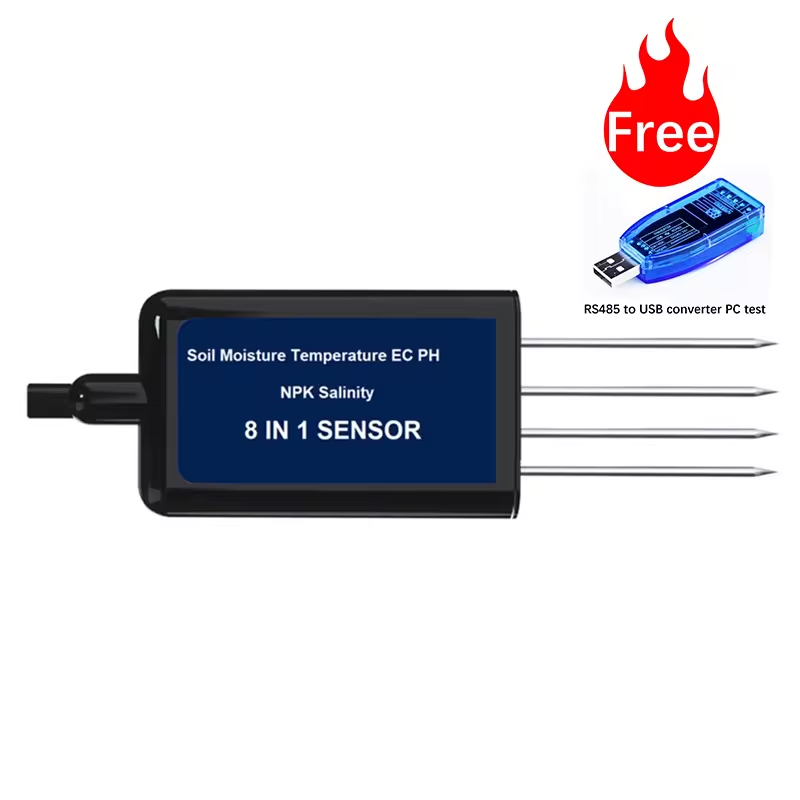Soil sensors are one solution that has proven its merit on smaller scales and could become invaluable for agricultural purposes.
What Are Soil Sensors?
Sensors track soil conditions, enabling real-time data collection and analysis. Sensors can track almost any soil characteristic, like the DNA of resident microorganisms, to shift the balance toward a healthier soil microbiome, increased yield, and reduced resource use.
The various types of sensors in agriculture use diverse methods, such as electrical signals and measuring the reflection of light waves, to ascertain the essential field characteristics that can transform farming operations.
Types of Soil Sensors
Soil sensors can measure soil characteristics such as moisture content, temperature, pH, salinity, humidity, photosynthetic radiation, and nutrient balance—chiefly the vital nitrogen, phosphorus, and potassium (NPK).
In addition to their crop management benefits, such as better grain quality and reduced nutrient leaching, soil sensors can inform forecasts around water resources, land stability, and climate change.
Other use cases include irrigation scheduling, watershed assessments, microbial ecology profiling, and plant disease prevention.
Benefits of Using Soil Sensors
Tracking soil status provides many benefits for farmers and gardeners, including increased crop yield and enhanced resource efficiency. IoT, cloud services, and AI integration allow growers to make data-driven decisions.
Sensors optimize fertilizer use, keep plants healthy, maximize resources, and minimize the runoff and off-gassing that attack the environment. Constant monitoring also prevents problems, such as pathogen outbreaks or soil compaction.
Monitoring the soil condition using soil sensors can also optimize fertilizer and water use. It’s estimated that approximately 30% of the nitrate fertilizer applied in the US washes away and contaminates water sources. Even adept irrigation systems can reach up to 50% water wastage, and agriculture is responsible for 70% of global freshwater usage. The ability to efficiently and effectively replenish soil moisture could have a big impact.
Installing and Calibrating Soil Sensors
Each sensor will have its own installation guide , but installation typically requires digging a hole or trench within a crop row and placing the sensors at multiple depths, including near the plant roots.
Over a large area, best practices dictate placement at sites indicative of the rest of the field or soil type to be managed, near water emitters, and in direct contact with soil (i.e., no air pockets). Sensor sites should also be flagged or otherwise marked on the surface to avoid accidental damage.
In addition to proper installation, sensor calibration is key. Soil sensors register soil moisture data as Volumetric Water Content (VWC), and each type of soil has its own VWC. Soil moisture sensors often have different sensitivities, and may need to be calibrated individually.
Troubleshooting
Equipment failures may occur due to electrical problems, interference from wildlife, or misconnected wires. Any air leaking into a tensiometer will make it unreliable. Ensuring the correct installation depth and waterproofing methods can help avoid future issues.
Common troubleshooting techniques include:
Chcking the power supply and circuitry
Cleaning the sensors without using chemicals
Performing regular maintenance to replace damaged parts according to the manufacturer’s repair guide
Monitoring Soil Health
Soil sensors offer a more accurate, streamlined strategy for soil health assessment. Conventional soil assessments are the equivalent of a biopsy, which can take weeks or months, depending on soil properties.
Sensor measurements are far quicker, taking an hour or two per 50 acres . The sensors display everything necessary for efficient crop management, including water content, water tension, and the presence of organic matter—a great indicator of overall soil health—without the need to physically remove soil samples.
Integration with Farm Management Systems
According to a StartUS Insights report, soil sensors are the most impactful soil monitoring technology due to their scalability, efficiency, and utility. Combining soil sensors with other burgeoning farming technologies, including AI-powered soil mapping, aerial imaging, automated soil monitoring robots, emissions trackers, augmented reality soil analysis, nanotechnology, and blockchain integration, can optimize farm management.
Challenges and Solutions in Soil Sensor Technology
Based on a 2020 University of Nebraska report, only 12% of US farms use soil moisture sensors to determine irrigation schedules. Soil sensors have become more viable due to significant improvements in accessibility, user-friendliness, and data processing and display capabilities, but more progress is needed.
Soil sensors must become more cost-efficient and interoperable for global adoption. Many types of sensors exist, resulting in a lack of standardization and compatibility.
Many existing technologies rely on proprietary sensors, which can make customization difficult. Advancements in sensor technology, like those developed by UC Berkeley, simplify onboarding to provide live data monitoring and promote agile decision-making across fields and markets.
Case Studies: Successful Implementation of Soil Sensors
Soil Sensors Help Farmers Save Water and Money
A Clemson University study found that soil moisture sensors can increase farmers’ average net income by 20% by increasing irrigation efficiency in tested fields that grew peanuts, soybeans, or cotton.
More Sustainable Sports Fields
Sporting venues are also adopting soil sensors. Wembley Stadium and Citizens Bank Park (the home of the Philadelphia Phillies) are among the sporting venues using soil sensors to maintain lush playing surfaces while maximizing water and energy use, according to soil sensor maker Soil Scout.
Future Trends in Soil Sensor Technology
Emerging trends include nanotechnology , with gold-or-silver-based nano-particles that increase sensor sensitivity for detecting soil pollutants like heavy metals.
Sensors coated with nano-compounds could track soil characteristics and then release nutrients, such as oxygen, in response to fluctuating soil quality. Others calculate bioindicators, like earthworm counts, or microorganism diversity, through DNA analysis, to improve the soil microbiome.
Post time: Apr-09-2024


